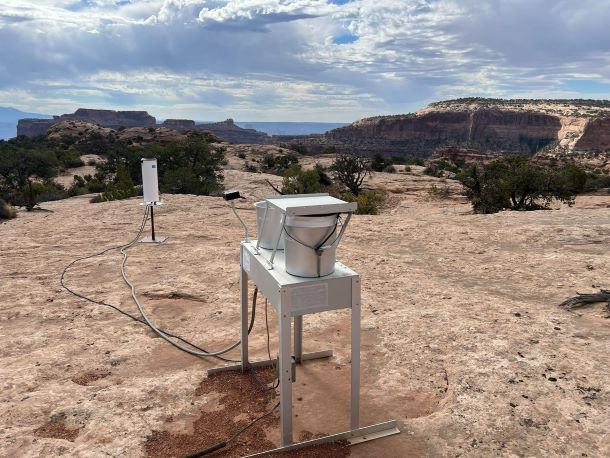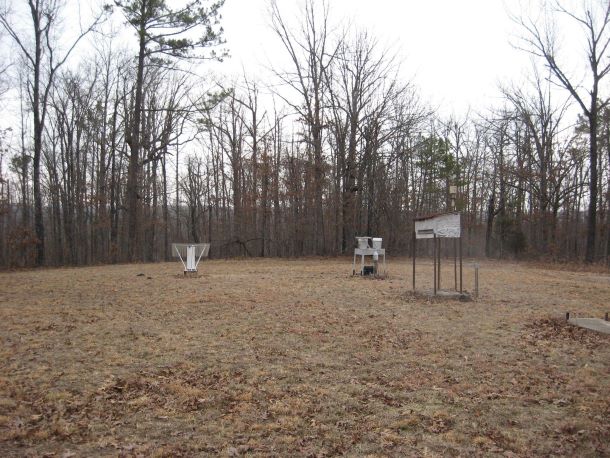|

|
Education and Outreach Subcommittee (EOS) Newsletter
Summer 2025
Hello, NADP members. This newsletter is an outlook on major upcoming events, product updates, and a review of recent milestones across NADP. Currently, this newsletter is shared twice per year, in between the fall and spring meetings.
Spring and Fall meetings:
Fall 2025 Meeting: Join us virtually for the NADP Fall Meeting from October 7 - 30, 2025. This meeting is an opportunity for the technical subcommittees and science committees to work on issues related to NADP management, network operations, and advancing deposition science. This virtual, no-cost meeting is open to everyone, and we welcome newcomers and long-time NADP members alike. For additional information regarding the structure of the Fall Meeting, please see the overview provided by Network Operation Subcommittee (NOS) below. Visit https://nadp.slh.wisc.edu/fall2025/.
Spring 2026 Science Symposium and Fall Meeting: Mark your calendars! Our annual science symposium will be held in the spring. This means that there will be no science symposium during our fall meeting. We will have more details regarding the dates and location of the science symposium following the fall meeting.
|
Program Office:
The NADP Program Office is responsible for assisting with program management and administering NADP operations.
Updates: The program office has been working on the annual map summaries for 2024. To see earlier versions of the map summaries, visit: https://nadp.slh.wisc.edu/pubs/Annual-Data-Summaries/. In addition, the PO has been working with the lab to transition the AMoN network from the Radiello to ALPHA samplers in January 2026.
The posting for the NADP Coordinator/Principal Investigator and Research Scientist is now open, this position will lead and coordinate NADP programmatic activities, working closely with NADP networks, committees, and collaborators to advance atmospheric deposition monitoring and data utilization. Full position description and application portal: https://jobs.wisc.edu/jobs/nadp-coordinator-madison-wisconsin-united-states. The closing date is August 25, 2025.
We welcome Ella Osby to the NADP site support team as the new Site Support Specialist. Ella will be working closely with the NED, PO, and NAL staff to support our site operators. She has jumped right in and has been communicating with sites on issues that arise with equipment, data communication, and operating procedures. Ella brings experience as a former NADP operator (UT09/CAN407), and will be a valuable asset to our team and will contribute positively to NADP's growth.
 UT09, Photo credit: A. Howell, NPS
UT09, Photo credit: A. Howell, NPS
|
NADP Executive Committee (EC):
The EC is responsible for executing decisions and actions brought forward by the subcommittees, advisory committees, science committees, and ad hoc groups; for making budgetary decisions; and for ensuring program continuity, stability, and balance.
Updates: The Executive Committee has been meeting regularly to discuss ongoing network sustainability efforts and plan for potential shifts in federal budgets and staffing. Network optimization efforts continue to be a priority with plans for field colocation studies to evaluate impacts on data quality. Finally, the Executive Committee, in collaboration with subcommittees and science committees, is continuing to build tools to support agencies in prioritizing network sites and fill spatial gaps within the network.
New members: The Executive Team nominated and approved Dr. David Felix as the NADP Executive Committee Secretary. Dr. Felix is currently an Associate Professor of Environmental Chemistry at Texas A&M University – Corpus Christi but recently accepted a position as the Carl B. Brown Distinguished Professor of Marine Science at the University of North Carolina Wilmington. We also welcome Dr. Kang Xia (Michigan State University) to the Executive Committee as the new SAES representative. Dr. Xia is the Associate Director of MSU AgBioResearch. Her research focuses on the occurrence, fate, and impact of emerging contaminants in soil and water systems and biogeochemistry of organic carbon, nitrogen, and phosphorus.
|
NADP science committees: science committees are focused on key areas of atmospheric deposition, scientific interest and/or applications.
Aeroallergen Monitoring Science Committee (AMSC): Aeroallergen Monitoring Science Committee (AMSC): The mission of the AMSC is to engage multidisciplinary stakeholders in advancing the science of aeroallergen monitoring, including identifying emerging technologies, evaluating methods to ensure data quality, coordination of monitoring stations, and possibly serving as a repository of long-term aeroallergen monitoring data.
Updates: All are welcome to the upcoming virtual AMSC meeting on September 22, 2025, at 2:00PM CDT. During this meeting, AMSC will discuss committee continuation, future priorities, frequency of meetings, and operations. If anyone is interested in attending the meeting, learning more about AMSC, or becoming involved, please reach out to Eric Uram at euram@wisc.edu. You can sign up for AMSC’s listserv here: nadp-amsc+subscribe@g-groups.wisc.edu
|
|
Critical Loads of Atmospheric Deposition (CLAD): Critical Loads of Atmospheric Deposition (CLAD): The objectives of CLAD are to identify risk to aquatic and terrestrial ecosystems from air pollution and advance the development and application of critical loads of atmospheric deposition to promote ecosystem health in the United States.
Updates: CLAD continues to develop critical load datasets based on the latest research and synthesize them into formats accessible through several online platforms, including the National Critical Load Database, Conditions and Trends Tool, and Critical Loads Assessment by Site (CLAS). Efforts are underway to update these sites with the most recent TDep data and also increase the access to these data by providing additional processed spatial data through the National Critical Load Database.
|
|
Mercury in the Environment and Links to Deposition Science Committee (MELD): Mercury in the Environmental and Links to Deposition (MELD): The mission of MELD is to improve our understanding of atmospherically-derived mercury sources, pathways, processes, and effects on the environment.
Updates: Passive Mercury Pilot Network: On January 1, 2025, NADP launched a passive mercury network pilot to complement its other mercury networks (AMNet, MDN, and MLN). This new network measures quarterly average Gaseous Elemental Mercury (GEM) concentrations using a passive sampler (Tekran MerPAS) deployed at eight U.S. locations. It offers a cost-effective method for potentially estimating dry deposition, addresses global data needs in support of the Convention, and advances NADP’s mission. The first quarter samples were collected in April, and the second set of samplers has been deployed. Data from the first quarter is expected to be released soon! Visit https://nadp.slh.wisc.edu/hg-passive-pilot-network/ for more information. Personnel: After the recent retirement of David Schmeltz after 25 years with EPA, Timothy Sharac took over the role as co-lead for MELD with Connor Olson. Timothy Sharac helped start AMNet with David Schmeltz, David Gay, Mark Olson, Eric Prestbo, and Martin Risch and previously measured ambient concentrations and wet deposition of mercury in graduate school.
|
|
Total Deposition Science Committee (TDep): Total Deposition Science Committee (TDep): The mission of TDep is to improve estimates of atmospheric deposition by advancing the science of measuring and modeling atmospheric wet, dry, and total deposition of species such as sulfur and nitrogen by providing a forum for the exchange of information on current and emerging issues within a broad multi-organization context including atmospheric scientists, ecosystem scientists, resource managers, and policy makers.
Updates: The National Park Service is conducting a collaborative field and laboratory comparison study for the SNiPiT Total Nitrogen/Total Phosphorous (TN/TP) add-on to the NTN. Samples will be collected at Colorado State University, Duke Forest, NC by the EPA and Coweeta, NC by the US Forest Service. The first samples will be collected soon and split between the NAL, CSU and RTI laboratories for analysis.
|
|
 AR16-Buffalo National River-Buffalo Point in Marion, Arkansas.
AR16-Buffalo National River-Buffalo Point in Marion, Arkansas.
This site was started in 1982. (Photo credit: EEMS Inc.)
|
NADP technical subcommittees: These committees advise the Executive Committee and develop initiatives, projects, and recommendations for program change.
Network Operations Subcommittee (NOS): Network Operation Subcommittee (NOS): The mission of the NOS is to provide a forum for discussion and evaluation of issues pertaining to station siting, equipment, and procedures for sampling and analysis in all NADP networks.
Updates: Fall meeting: NOS has been preparing for the Fall 2025 meeting. A tentative agenda will be emailed to NADP members for the Block, Joint, and NOS sessions. All comments or suggestions for additional agenda items must be submitted by September 2 to Noel Deyette (ndeyette@usgs.gov). The fall meeting will be scheduled across multiple dates, starting on October 7 with Critical Loads of Atmospheric Deposition (CLAD). October 14 will be the virtual NOS session (3 hours). October 28 will be the virtual Joint I session. Discussion will include: a) the upcoming transition of the Radiello samplers to the ALPHA samplers for the AMoN network (which was approved with a motion at the August Executive Committee meeting); b) the continuation of the co-located study through at least the end of calendar year 2025; c) the transition of PFN network to an official NADP network. October 30 will be the virtual Joint II session. Discussion will be focused on the proposed changes to network operations. Time will be dedicated to individual subcommittees, advisory committees, science committees, and ad hoc groups to discuss the ramifications of these changes on data products, research initiatives, and logistics and operations. NOS requests that science committee chairs include these discussions of proposed changes and potential ramifications in their upcoming meeting agendas, and/or convene virtual meetings prior to the virtual Fall meeting.
|
|
Education and Outreach Committee (EOS): Education and Outreach Subcommittee (EOS): The mission of EOS is to coordinate outreach and education activities among the network and scientific subcommittees.
Updates: Network optimization summary document: EOS is developing a document summarizing the network optimization discussions from the spring meeting. Prior to the fall meeting, EOS will be reviewing videos, reaching out to speakers for clarification, and creating a draft version of the document. Educational activities: EOS and the Program Office are supporting partnerships with high schools and working on developing educational and outreach materials. Web updates: Since the spring meeting, we have published the newest version of the NADP fact sheet and created an abbreviation list for the website: https://nadp.slh.wisc.edu/wp-content/uploads/factsheets/NADP_Factsheet_Final.pdf and https://nadp.slh.wisc.edu/acronyms/
|
NADP Advisory Groups: These advisory groups advise the Executive Committee on quality management, quality assurance, and data management for networks and programs.
Quality Assurance Advisory Group (QAAG): Quality Assurance Advisory Group (QAAG): QAAG advises the Executive Committee on matters of quality management and quality assurance for the NADP Program Office, networks, and laboratories. The QAAG also makes recommendations on the external QA programs and advises the Executive Committee on matters related to these programs.
Updates: The proposed change to the sample bucket lid protocol for NTN is being tested internally at our location associated with UW Madison to make sure the documentation of the change is thorough. The proposed implementation, site-wide, would be during the first sample change out of 2026. The pilot study of the ALPHA samplers for AMoN is almost complete and the data was presented to the Executive Committee for approval of the supply change. The 2024 QAR is currently going through internal review and should be available on the NADP website soon.
|
|
Data Management Advisory Group: Data Management Advisory Group (DMAG): The DMAG advises the Executive Committee on matters of data management for the NADP Program Office, networks, and laboratories.
Updates: The NADP MDN Methylmercury data has been published on the MDN site (https://nadp.slh.wisc.edu/networks/mercury-deposition-network/). This includes all available data between 1996 to 2022.
|
|




© 2024 National Atmospheric Deposition Program
465 Henry Mall, Madison, Wisconsin 53706
email: nadp@slh.wisc.edu
To unsubscribe from this group and stop receiving emails from it,
send an email to nadp-announce+unsubscribe@g-groups.wisc.edu.
|
|